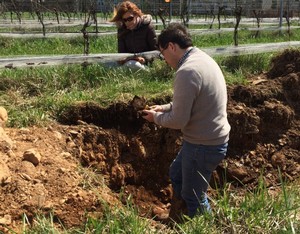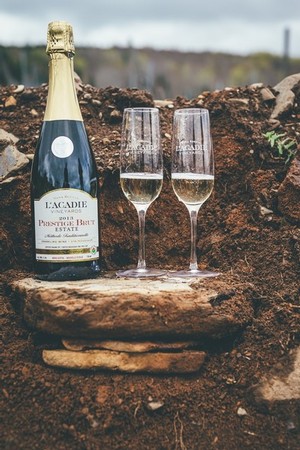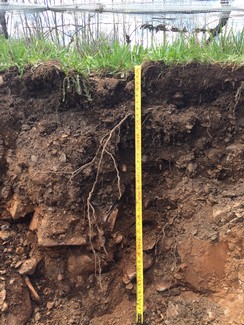Discovering Rocks
Discovering Rocks
Our journey to find our unique terroir started when were still living in BC’s Okanagan Valley. Vacations to visit family in Nova Scotia always included visiting local wineries such as Domaine de Grand Pre and enjoying their delicious L’Acadie Blanc still wines - beautiful dry fruity wines with balanced crisp acidity that reminded me of the ideal structure for sparkling base wines that I pursued in Okanagan and sometimes failed to find. These wines were grown on typical heavy soils with loamy clay on south slopes and today I believe intense fruit expression from those sites is partially from soil water holding capacity and vigour. We were looking for a property to grow Nova Scotia’s first sparkling wine, so sipping wine and discussing soils late into the night centred on sparkling and where for OUR L’Acadie Blanc. I had experienced the effects of site and soil on wine characteristics in my BC career many times, a good example is Pinot Noir with drying tannins made from sandy soils of the hot Black Sage Bench sub-appellation compared to the more luscious juicy Pinot Noir from heavier soils and cooler days in adjacent Similkameen Valley. I also understood the importance of harmony in a sparkling base wine – the balance between fruit expression and bottle aging toastiness, an ever-changing dance that can be shifted unfavourably with too much fruit intensity with varieties such as, but not limited to, muscat. Yes, a European approach, but I was making sparkling with European varieties such as Chardonnay and Riesling and tried to maintain typicity. Guiding all of our discussions was a conviction to do it organically, for better flavours like I had seen winemaking at Summerhill Pyramid Winery, and for our family and our future neighbours' health.
We found our 30 acres of Gaspereau paradise online in BC. It was listed as a tourist accommodation business, hobby horse farm and residence, and the horse pasture caught our eye for grapes with thankfully no interventions on the land for years and protected from conventional agriculture with robust buffers. Many investigations later revealed rocky well-drained soil on a bench sloping 5% northwest, a uniquely different aspect and soil than rich clay-dominant vineyards on the other side of Gaspereau Valley and counter to the manta of the time “need south slope, need south slope”. Bubbling up from mixed local wine grower opinions was the long-standing history of good producing now removed apple trees on the property by the Duncanson family 50-100 years ago and our knowledge of matching soil, varietal and wine style. We took a chance that the terroir would give us the sparklings that we envisioned - mineral, saline.
Read more about why Nova Scotia sparkling, Cooler Climate Nova Scotia

Next year marks 20 years and our decision to plant organic L’Acadie Blanc on these soils has been validated with numerous international sparkling awards. It hasn’t been easy for the vines as they slowly stretched their roots straight down deep through schist, sandstone, slate and gravels. Now they are strongly rooted with symbiotic fungal network filaments that extend their reach for nutrients, making them more resilient to climate change and, more immediately apparent, sourcing and expressing their terroir very clearly. Wine judges have been noticing our flavours especially in organic wine Prestige Brut Estate (PBE) sourced from the same block every year with more topsoil (8 vs 6 inches) and more vigour than other blocks on the property.
Read more about climate change, Climate Change and Nova Scotia Sparkling

“Open and powerful nose with grilled hazelnut, pineapple, lemon and honey” 2010 PBE, Effervescent du Monde, silver
"A floral, apple nose with chalky lemon and creamy pear on the refreshing, mineral palate." 2013 PBE, Decanter, 92 points
"Complex apple, peach, nut and citrus bouquet with a toasty palate and fine mousse" 2014 PBE, Decanter, 92 points
"Perfumed with rose, white peach and toast; and a bright palate of zesty lime zest and apple." 2015 PBE, Decanter, 88 points
"Pretty and attractive, with white fruit, honey melon, chalky green apple and lifted floral aromatics lead through to a palate of vibrant acidity, citrus curd and a fine, saline finish." 2017 PBE, Decanter, 95 points
Minerality and more focused terms such as electricity, vibrancy and zesty can be used to describe our terroir and as well as an underlying descriptor of slight saline related to ancient seabed origins of our mainly sedimentary rocks. We continue to build the soil and rhizosphere with vegan viticulture inputs of composted grape pomace teeming with microorganisms and humus to nurture topsoil and below. This topsoil on top of rocky profiles is analogous to Champagne’s Grand Cru parcels with their topsoil over chalky soil and provides a living window to the surface contributing crucial elements such as atmospheric nitrogen fixed by clover and other plants in our cover crops.
To say we are excited about the future gifts our vineyard will yield is an understatement. Roots will get deeper and source more flavours, and we have expanded the estate to include new plantings of Chardonnay, Pinot Noir and Sauvignon Blanc, my old friends.

